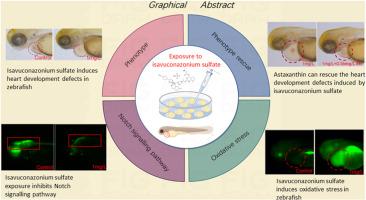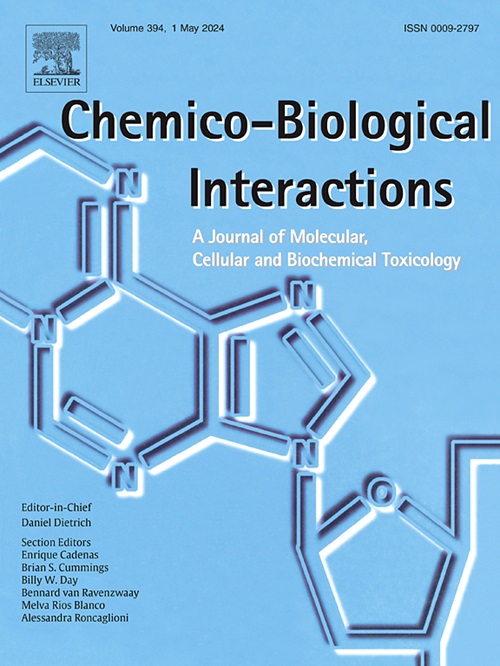Isavuconazonium sulfate induces heart development defects in zebrafish larvae by upregulation of oxidative stress
IF 4.7
2区 医学
Q1 BIOCHEMISTRY & MOLECULAR BIOLOGY
引用次数: 0
Abstract
Environmental pollution remains a pressing global concern, with a substantial number of annual fatalities attributed to pollution-induced diseases. One emerging facet of environmental pollution is drug contamination, whereby pharmaceutical compounds can readily infiltrate water sources during manufacturing or utilization, subsequently being detected in various aquatic ecosystems. Some drugs have been detected in many watersheds at concentrations that can cause toxicity to aquatic organisms. Isavuconazonium sulfate (ISAV-SF), a prevalent antifungal medication, is no exception, warranting an exploration of its potential toxicity. However, limited research has been conducted in this domain. In this investigation, zebrafish were employed as a model organism to scrutinize the cardiotoxicity of ISAV-SF. Exposure of zebrafish embryos to concentrations of 0.5, 0.75, and 1 mg/L of ISAV-SF resulted in noteworthy cardiac developmental aberrations. These anomalies encompassed enlarged pericardial area, diminished heart rate, alterations in SV-BA distance, and the detachment of cardiomyocytes from the endocardium. Exposure to ISAV-SF caused disruption of the expression of genes related to cardiac development (gata4, klf2a, nkx2.5, vmhc, tbx2b), especially in the high concentration group. Moreover, the Notch signaling pathway was inhibited and oxidative stress levels were upregulated in all exposed groups. Remarkably, the administration of the antioxidant astaxanthin effectively mitigated oxidative stress levels, thus ameliorating heart developmental impairments. These results suggest that ISAV-SF may contribute to cardiac developmental defects by upregulating oxidative stress. This study serves as a pivotal reference for the utilization of ISAV-SF within the market, emphasizing the necessity to curtail its introduction into aquatic environments during production and consumption and to evaluate its repercussions on aquatic organisms.

硫酸异芥子铵通过上调氧化应激诱导斑马鱼幼体心脏发育缺陷。
环境污染仍然是全球亟待解决的问题,每年都有大量人员死于污染引发的疾病。环境污染的一个新方面是药物污染,药物化合物在生产或使用过程中很容易渗入水源,随后在各种水生生态系统中被检测到。在许多流域都检测到了一些药物,其浓度可对水生生物造成毒性。常见的抗真菌药物硫酸异琥珀酰亚胺(ISAV-SF)也不例外,因此有必要对其潜在毒性进行研究。然而,这方面的研究还很有限。在这项研究中,斑马鱼被用作研究 ISAV-SF 心脏毒性的模式生物。斑马鱼胚胎暴露于 0.5、0.75 和 1 毫克/升浓度的 ISAV-SF 后,会出现显著的心脏发育畸变。这些异常包括心包面积增大、心率减慢、SV-BA 距离改变以及心肌细胞从心内膜脱离。暴露于ISAV-SF会导致与心脏发育相关的基因(gata4、klf2a、nkx2.5、vmhc、tbx2b)表达紊乱,尤其是在高浓度组。此外,在所有暴露组中,Notch 信号通路受到抑制,氧化应激水平上调。值得注意的是,服用抗氧化剂虾青素可有效缓解氧化应激水平,从而改善心脏发育障碍。这些结果表明,ISAV-SF可能通过上调氧化应激导致心脏发育缺陷。这项研究为在市场上使用 ISAV-SF 提供了重要参考,强调了在生产和消费过程中减少将其引入水生环境并评估其对水生生物影响的必要性。
本文章由计算机程序翻译,如有差异,请以英文原文为准。
求助全文
约1分钟内获得全文
求助全文
来源期刊
CiteScore
7.70
自引率
3.90%
发文量
410
审稿时长
36 days
期刊介绍:
Chemico-Biological Interactions publishes research reports and review articles that examine the molecular, cellular, and/or biochemical basis of toxicologically relevant outcomes. Special emphasis is placed on toxicological mechanisms associated with interactions between chemicals and biological systems. Outcomes may include all traditional endpoints caused by synthetic or naturally occurring chemicals, both in vivo and in vitro. Endpoints of interest include, but are not limited to carcinogenesis, mutagenesis, respiratory toxicology, neurotoxicology, reproductive and developmental toxicology, and immunotoxicology.

 求助内容:
求助内容: 应助结果提醒方式:
应助结果提醒方式:


